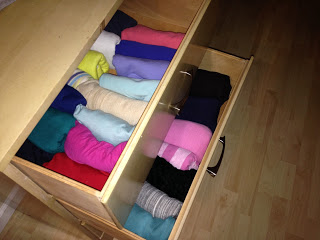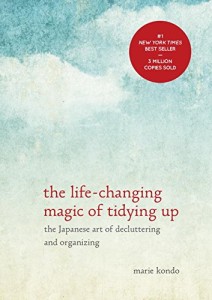The title of Marie Kondo’s book, “The Life-Changing Magic of Tidying Up: The Japanese Art of Decluttering and Organizing” makes a big promise. Can tidying your home really be life-changing or magical? I picked up a copy at the library anyway, intrigued by the title and pretty cover. I’ve been using the KonMari method for over a month now, and yes, it does live up to its promises.
Usually I’m not a fan of “self help” books or books that promise to change my life. I’ve also struggled with clutter, and I’ve had “home organization” books sitting unread on my shelves for years (thanks for the subtle hints, Mom). This one is completely different. It’s actually fun to read, the KonMari Method really works, and you don’t have to go out and spend a lot of money on storage boxes. Here’s how it has worked for me.
KonMari Method Theory
Kondo’s theory is simple: only keep things that “spark joy.” Don’t worry about whether something is useful, valuable, given to you by a loved one, or something you “should” have. Don’t keep things just because you’ve always had them. Instead, touch and examine every object in your house and ask yourself, “Does this spark joy?” If it does, then keep it. If it doesn’t, dispose of it.
KonMari Method Process
Feeling overwhelmed yet? The idea of examining every single thing you own sounds pretty daunting, or at least it did to me at first. Kondo recognizes this, so she advises going through the process as quickly as possible. She criticizes the “tidy a little every day” approach that you often find in books and articles. Instead, tidying should be a one-time “big event,” not a series of small tasks trying to gradually (and ineffectively) get rid of clutter.
Kondo estimates that your “big event” tidying will take about six months, which is a long time, but she claims that you’ll never go back to the clutter you had before you implemented the KonMari Method. So far the areas that I’ve tidied using her method have stayed clutter-free. Also, I’ve been working on it for about six weeks and am about halfway through; so the six months is an estimate, not a firm deadline.
 |
| Clothes pile before sorting. |
The second revolutionary idea is to tidy by item, not location. She points out that when you tidy by room, you often find yourself organizing the same types of things over and over. Instead, you gather all of your stuff in one category and sort it all at once.
I set aside space in my living room, which isn’t used every day, so that I could go through everything without getting in the way of normal family life. I varied from the book’s method by starting with papers, then clothes. I pulled all of the papers stashed all around the house: papers stuffed into drawers or cabinets, boxes of papers stored in the basement from my grad school/teaching days, papers that were stacked on a table in my office, waiting to be sorted. They filled the room.
I’ve always dreaded organizing my papers, but I got it done in two afternoon sessions. I had so many boxes of things I’d kept “just in case” that I never really needed. I dumped so many that I went from having enough papers to fill a room to having just enough for a 2-drawer filing cabinet (with room to spare).
If I had tidied by room, I would still be working on paper organization. By doing it all at once, I got it over with and freed up space in multiple places around my house.
I did the same thing with “junk drawers.” I removed all of the junk drawers from around the house and brought them into the living room. After clearing them out, I gave each drawer a purpose. A drawer in my kitchen that once held everything from box tops to cookie cutters to fish food (for fish who died months ago) now has a small notepad, Post-It notes, labels, pens, and markers. It’s the “list and label-making” drawer. Nothing goes into it that doesn’t fit its purpose. I love opening that drawer and seeing exactly what I need instead of an assortment of junk.
Writing Style
Much of the book’s charm is the writing style. Kondo treats objects like living things with feelings, which I first found confusing, then charming, and later, surprisingly useful. For example, one passage begins, “Have you ever had the experience where you thought what you were doing was a good thing but later learned that it had hurt someone? At the time, you were totally unconcerned, oblivious to the other person’s feelings. This is somewhat similar to the way many of us treat our socks.”
| Socks? Socks have feelings?
But it works. She goes on to explain that when you ball up your socks, you’re stretching out the elastic. That makes sense, but the mental image of socks having hurt feelings is far more effective than just explaining the practical side. I’ve also discovered what Kondo states repeatedly: the more I choose items that “spark joy,” the more I enjoy my possessions, and yes, they do start to take on a life of their own. And the more I appreciate my things, the more I use them, and the better I take care of them. For example, I have a set of china plates and cups that I bought at a garage sale a few years ago and have always loved. They’re not valuable, but I think they’re beautiful. I used to keep them in a china cabinet, hoping someday I’d have an excuse to use them. When I cleared out all the dishes that didn’t spark joy, I moved these into an open cabinet in my kitchen. Now I use them for breakfast every morning, and the sight of periwinkle flowers on white china makes me smile. When I wash them, I treat them with more care than I did the stacks of dishes I’d kept around because they were “useful.” |
KonMari Method Experience: the good and the bad
I’m not going to lie and say that this process has been easy or painless. I’ve moved so many heavy objects and books lately that I swear my biceps are bigger. Massive de-cluttering takes physical effort and time, creates a short-term mess that can be frustrating, and is an emotional process. I’ve had plenty of moments of doubt (usually ending in giving up the item anyway, despite initial reservations) and momentary pangs of loss.
But the benefits far outweigh the difficulties. I’ve never enjoyed my home as much as I do right now, and I’m only halfway done. My books are a great example of the KonMari Method at work.
 |
| All the junk drawers! |
Over the years, I’d accumulated about 500 books. That doesn’t include my husband’s books (about the same number) or my kids’ (another crowded bookshelf.) We’re big readers around here.
In two days, I’d cut my personal collection of books in half. Weeding through my books was easy, but actually taking them to the used bookstore to sell was more painful. I’ve always prided myself on my large collection of highbrow literature and essays, collected during my years of grad school and teaching college.
But when I was done, I experienced what she describes in the book: the joy of seeing all of my favorite books together, organized and easy to find. I honestly enjoy my books more than I have in years. And if I want to buy a book, I can do so without worrying about finding shelf space. I now have bookshelf space to spare, which is something I’ve never had before.
Final thoughts on the KonMari Method
If I’ve convinced you to read this book about the KonMari Method, you will discover that she has a sequel, Spark Joy, which is more of a how-to guide. I have both books, but I’ve used the first one more than the second. The second book has pictures and instructions on things like folding and organizing, while the first book has more personal stories and explanations of her basic philosophy on the KonMari Method. You could use either one, depending on what you’re looking for.With either book, you’ll find great ideas, quirky writing, and a lot of encouragement. And you just might find that getting your home organized really does feel like magic.
First time here? Like Mumbling Mommy on Facebook to continue the conversation!
Category: HomeTags: decluttering










